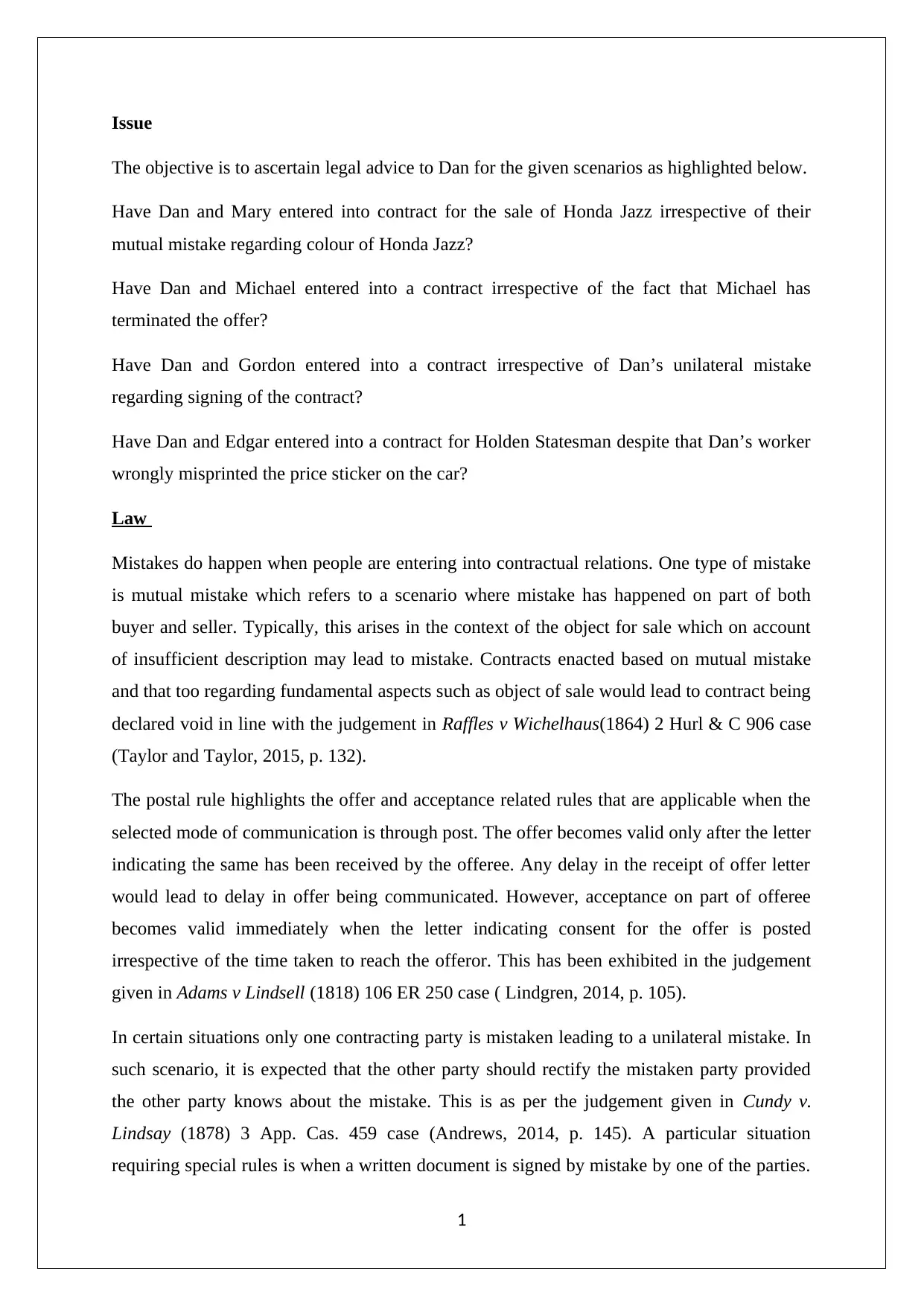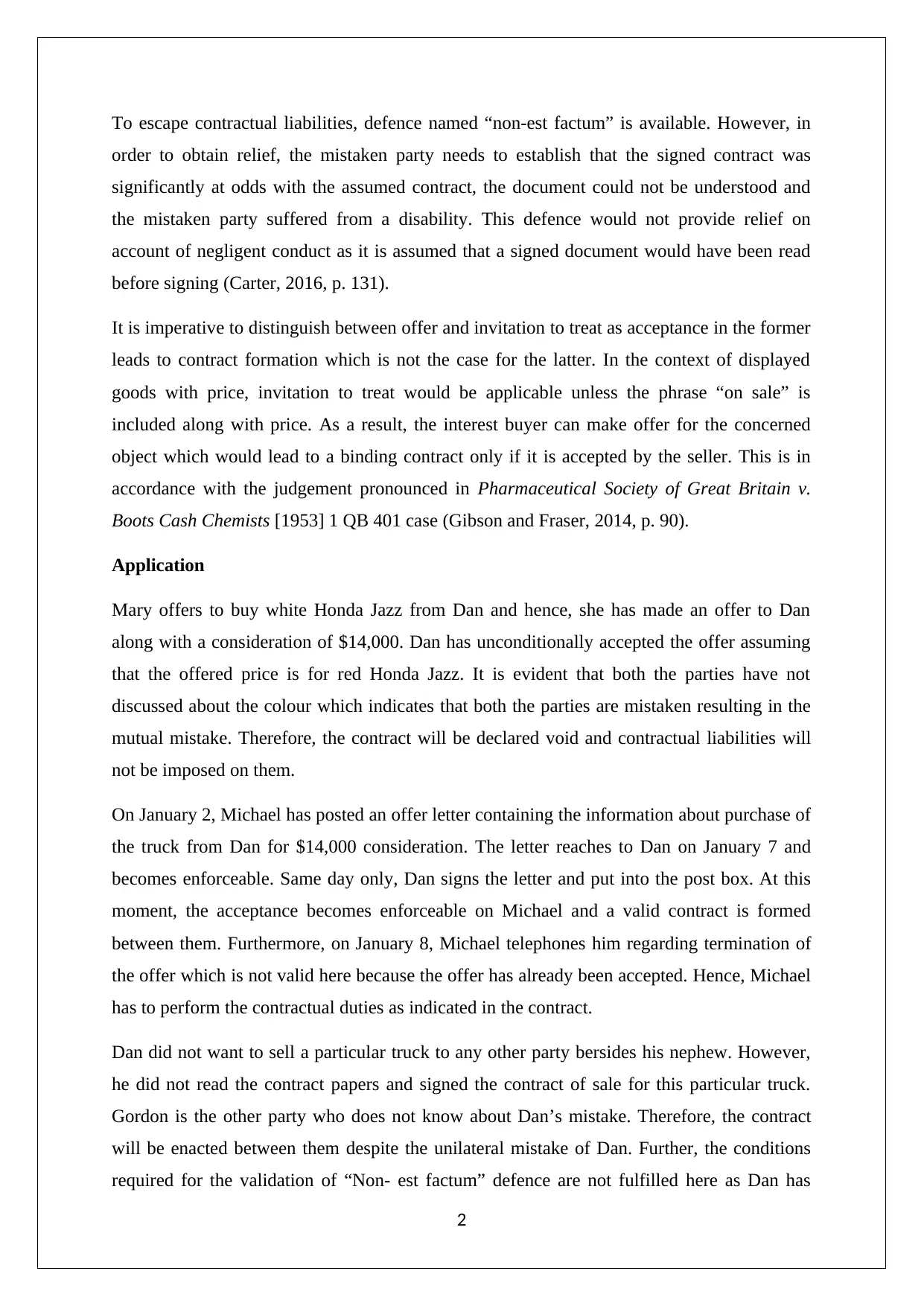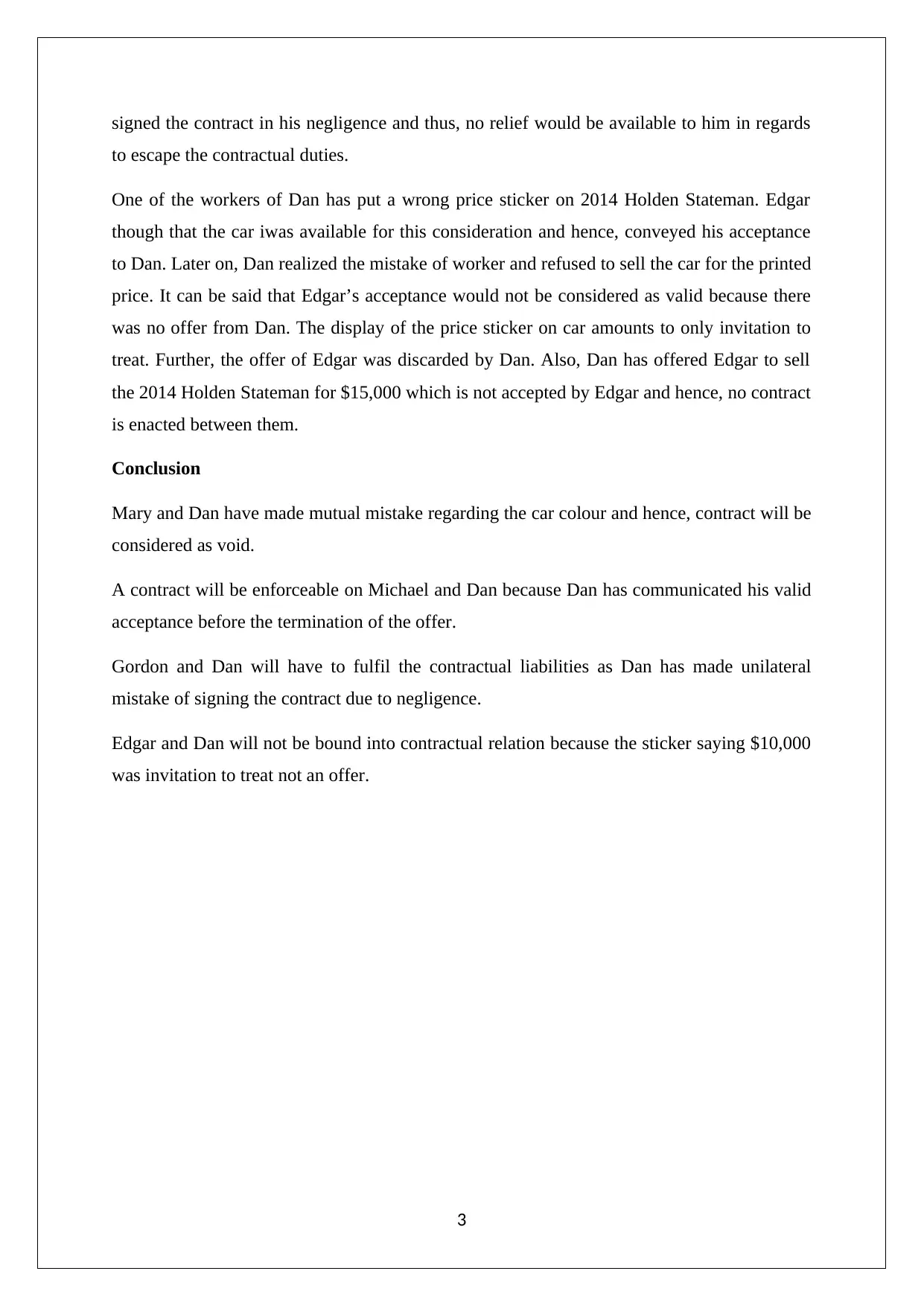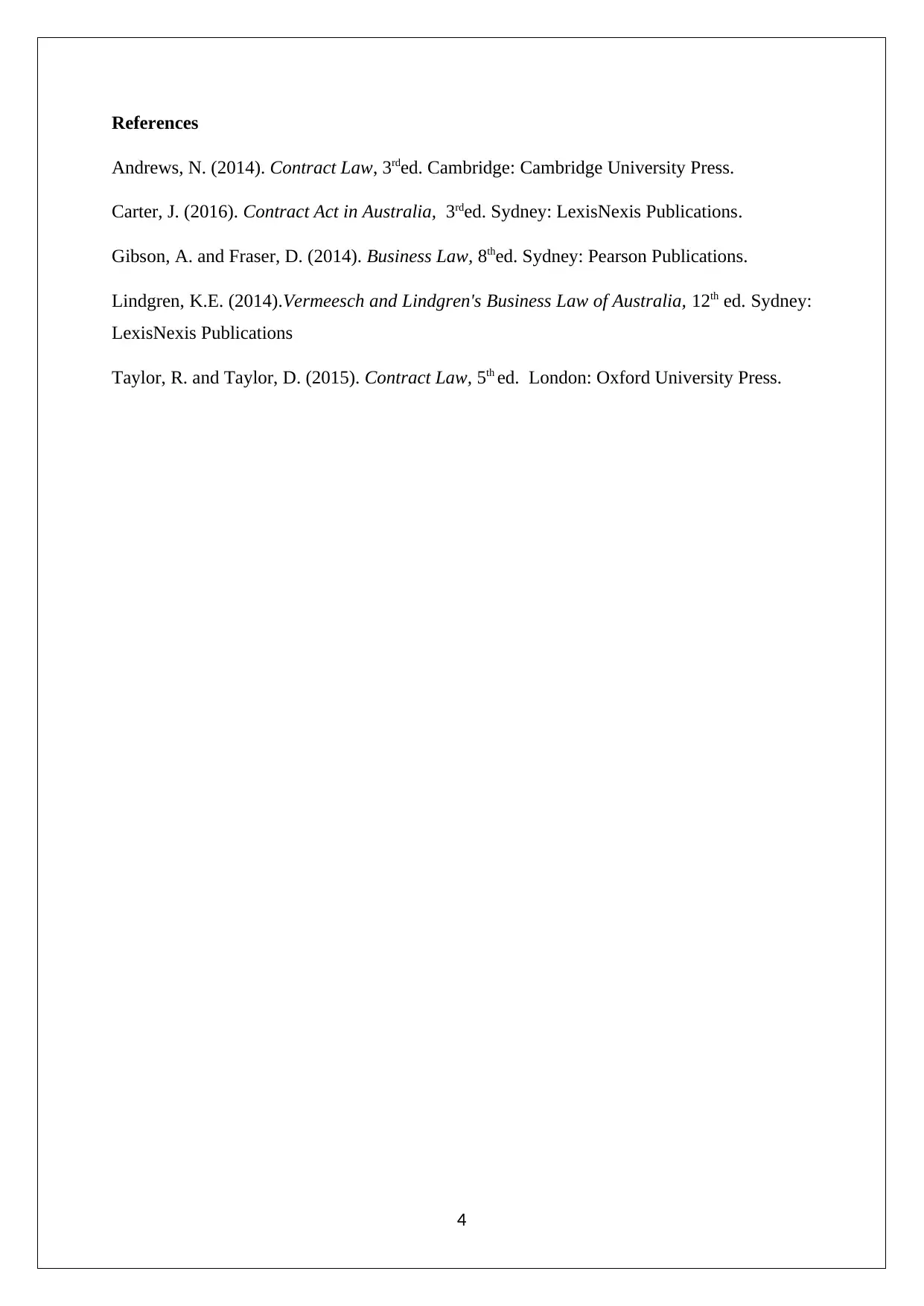Dan's Car Business: Contract Law Issues and Legal Advice (Semester 2)
VerifiedAdded on 2023/01/12
|5
|1300
|54
Case Study
AI Summary
This assignment analyzes several contract law issues faced by Dan, a second-hand car dealer, providing legal advice for each scenario. The analysis begins with a mutual mistake scenario involving Mary and the color of a Honda Jazz, concluding that no contract was formed. Next, it examines a situation where Michael attempted to terminate an offer after Dan had already accepted it, determining that a valid contract exists. The assignment then considers Dan's unilateral mistake in signing a contract with Gordon, concluding that a contract is still enforceable due to Dan's negligence and the absence of conditions for the defense of 'non-est factum'. Finally, it assesses a case where a worker misprinted a price sticker, leading to a potential contract with Edgar, concluding that the sticker was an invitation to treat, and no contract was formed. The assignment uses the ILAC (Issue, Law, Application, Conclusion) format and cites relevant case law to support its legal reasoning.

STUDENT ID& NAME
Paraphrase This Document
Need a fresh take? Get an instant paraphrase of this document with our AI Paraphraser

Issue
The objective is to ascertain legal advice to Dan for the given scenarios as highlighted below.
Have Dan and Mary entered into contract for the sale of Honda Jazz irrespective of their
mutual mistake regarding colour of Honda Jazz?
Have Dan and Michael entered into a contract irrespective of the fact that Michael has
terminated the offer?
Have Dan and Gordon entered into a contract irrespective of Dan’s unilateral mistake
regarding signing of the contract?
Have Dan and Edgar entered into a contract for Holden Statesman despite that Dan’s worker
wrongly misprinted the price sticker on the car?
Law
Mistakes do happen when people are entering into contractual relations. One type of mistake
is mutual mistake which refers to a scenario where mistake has happened on part of both
buyer and seller. Typically, this arises in the context of the object for sale which on account
of insufficient description may lead to mistake. Contracts enacted based on mutual mistake
and that too regarding fundamental aspects such as object of sale would lead to contract being
declared void in line with the judgement in Raffles v Wichelhaus(1864) 2 Hurl & C 906 case
(Taylor and Taylor, 2015, p. 132).
The postal rule highlights the offer and acceptance related rules that are applicable when the
selected mode of communication is through post. The offer becomes valid only after the letter
indicating the same has been received by the offeree. Any delay in the receipt of offer letter
would lead to delay in offer being communicated. However, acceptance on part of offeree
becomes valid immediately when the letter indicating consent for the offer is posted
irrespective of the time taken to reach the offeror. This has been exhibited in the judgement
given in Adams v Lindsell (1818) 106 ER 250 case ( Lindgren, 2014, p. 105).
In certain situations only one contracting party is mistaken leading to a unilateral mistake. In
such scenario, it is expected that the other party should rectify the mistaken party provided
the other party knows about the mistake. This is as per the judgement given in Cundy v.
Lindsay (1878) 3 App. Cas. 459 case (Andrews, 2014, p. 145). A particular situation
requiring special rules is when a written document is signed by mistake by one of the parties.
1
The objective is to ascertain legal advice to Dan for the given scenarios as highlighted below.
Have Dan and Mary entered into contract for the sale of Honda Jazz irrespective of their
mutual mistake regarding colour of Honda Jazz?
Have Dan and Michael entered into a contract irrespective of the fact that Michael has
terminated the offer?
Have Dan and Gordon entered into a contract irrespective of Dan’s unilateral mistake
regarding signing of the contract?
Have Dan and Edgar entered into a contract for Holden Statesman despite that Dan’s worker
wrongly misprinted the price sticker on the car?
Law
Mistakes do happen when people are entering into contractual relations. One type of mistake
is mutual mistake which refers to a scenario where mistake has happened on part of both
buyer and seller. Typically, this arises in the context of the object for sale which on account
of insufficient description may lead to mistake. Contracts enacted based on mutual mistake
and that too regarding fundamental aspects such as object of sale would lead to contract being
declared void in line with the judgement in Raffles v Wichelhaus(1864) 2 Hurl & C 906 case
(Taylor and Taylor, 2015, p. 132).
The postal rule highlights the offer and acceptance related rules that are applicable when the
selected mode of communication is through post. The offer becomes valid only after the letter
indicating the same has been received by the offeree. Any delay in the receipt of offer letter
would lead to delay in offer being communicated. However, acceptance on part of offeree
becomes valid immediately when the letter indicating consent for the offer is posted
irrespective of the time taken to reach the offeror. This has been exhibited in the judgement
given in Adams v Lindsell (1818) 106 ER 250 case ( Lindgren, 2014, p. 105).
In certain situations only one contracting party is mistaken leading to a unilateral mistake. In
such scenario, it is expected that the other party should rectify the mistaken party provided
the other party knows about the mistake. This is as per the judgement given in Cundy v.
Lindsay (1878) 3 App. Cas. 459 case (Andrews, 2014, p. 145). A particular situation
requiring special rules is when a written document is signed by mistake by one of the parties.
1

To escape contractual liabilities, defence named “non-est factum” is available. However, in
order to obtain relief, the mistaken party needs to establish that the signed contract was
significantly at odds with the assumed contract, the document could not be understood and
the mistaken party suffered from a disability. This defence would not provide relief on
account of negligent conduct as it is assumed that a signed document would have been read
before signing (Carter, 2016, p. 131).
It is imperative to distinguish between offer and invitation to treat as acceptance in the former
leads to contract formation which is not the case for the latter. In the context of displayed
goods with price, invitation to treat would be applicable unless the phrase “on sale” is
included along with price. As a result, the interest buyer can make offer for the concerned
object which would lead to a binding contract only if it is accepted by the seller. This is in
accordance with the judgement pronounced in Pharmaceutical Society of Great Britain v.
Boots Cash Chemists [1953] 1 QB 401 case (Gibson and Fraser, 2014, p. 90).
Application
Mary offers to buy white Honda Jazz from Dan and hence, she has made an offer to Dan
along with a consideration of $14,000. Dan has unconditionally accepted the offer assuming
that the offered price is for red Honda Jazz. It is evident that both the parties have not
discussed about the colour which indicates that both the parties are mistaken resulting in the
mutual mistake. Therefore, the contract will be declared void and contractual liabilities will
not be imposed on them.
On January 2, Michael has posted an offer letter containing the information about purchase of
the truck from Dan for $14,000 consideration. The letter reaches to Dan on January 7 and
becomes enforceable. Same day only, Dan signs the letter and put into the post box. At this
moment, the acceptance becomes enforceable on Michael and a valid contract is formed
between them. Furthermore, on January 8, Michael telephones him regarding termination of
the offer which is not valid here because the offer has already been accepted. Hence, Michael
has to perform the contractual duties as indicated in the contract.
Dan did not want to sell a particular truck to any other party bersides his nephew. However,
he did not read the contract papers and signed the contract of sale for this particular truck.
Gordon is the other party who does not know about Dan’s mistake. Therefore, the contract
will be enacted between them despite the unilateral mistake of Dan. Further, the conditions
required for the validation of “Non- est factum” defence are not fulfilled here as Dan has
2
order to obtain relief, the mistaken party needs to establish that the signed contract was
significantly at odds with the assumed contract, the document could not be understood and
the mistaken party suffered from a disability. This defence would not provide relief on
account of negligent conduct as it is assumed that a signed document would have been read
before signing (Carter, 2016, p. 131).
It is imperative to distinguish between offer and invitation to treat as acceptance in the former
leads to contract formation which is not the case for the latter. In the context of displayed
goods with price, invitation to treat would be applicable unless the phrase “on sale” is
included along with price. As a result, the interest buyer can make offer for the concerned
object which would lead to a binding contract only if it is accepted by the seller. This is in
accordance with the judgement pronounced in Pharmaceutical Society of Great Britain v.
Boots Cash Chemists [1953] 1 QB 401 case (Gibson and Fraser, 2014, p. 90).
Application
Mary offers to buy white Honda Jazz from Dan and hence, she has made an offer to Dan
along with a consideration of $14,000. Dan has unconditionally accepted the offer assuming
that the offered price is for red Honda Jazz. It is evident that both the parties have not
discussed about the colour which indicates that both the parties are mistaken resulting in the
mutual mistake. Therefore, the contract will be declared void and contractual liabilities will
not be imposed on them.
On January 2, Michael has posted an offer letter containing the information about purchase of
the truck from Dan for $14,000 consideration. The letter reaches to Dan on January 7 and
becomes enforceable. Same day only, Dan signs the letter and put into the post box. At this
moment, the acceptance becomes enforceable on Michael and a valid contract is formed
between them. Furthermore, on January 8, Michael telephones him regarding termination of
the offer which is not valid here because the offer has already been accepted. Hence, Michael
has to perform the contractual duties as indicated in the contract.
Dan did not want to sell a particular truck to any other party bersides his nephew. However,
he did not read the contract papers and signed the contract of sale for this particular truck.
Gordon is the other party who does not know about Dan’s mistake. Therefore, the contract
will be enacted between them despite the unilateral mistake of Dan. Further, the conditions
required for the validation of “Non- est factum” defence are not fulfilled here as Dan has
2
⊘ This is a preview!⊘
Do you want full access?
Subscribe today to unlock all pages.

Trusted by 1+ million students worldwide

signed the contract in his negligence and thus, no relief would be available to him in regards
to escape the contractual duties.
One of the workers of Dan has put a wrong price sticker on 2014 Holden Stateman. Edgar
though that the car iwas available for this consideration and hence, conveyed his acceptance
to Dan. Later on, Dan realized the mistake of worker and refused to sell the car for the printed
price. It can be said that Edgar’s acceptance would not be considered as valid because there
was no offer from Dan. The display of the price sticker on car amounts to only invitation to
treat. Further, the offer of Edgar was discarded by Dan. Also, Dan has offered Edgar to sell
the 2014 Holden Stateman for $15,000 which is not accepted by Edgar and hence, no contract
is enacted between them.
Conclusion
Mary and Dan have made mutual mistake regarding the car colour and hence, contract will be
considered as void.
A contract will be enforceable on Michael and Dan because Dan has communicated his valid
acceptance before the termination of the offer.
Gordon and Dan will have to fulfil the contractual liabilities as Dan has made unilateral
mistake of signing the contract due to negligence.
Edgar and Dan will not be bound into contractual relation because the sticker saying $10,000
was invitation to treat not an offer.
3
to escape the contractual duties.
One of the workers of Dan has put a wrong price sticker on 2014 Holden Stateman. Edgar
though that the car iwas available for this consideration and hence, conveyed his acceptance
to Dan. Later on, Dan realized the mistake of worker and refused to sell the car for the printed
price. It can be said that Edgar’s acceptance would not be considered as valid because there
was no offer from Dan. The display of the price sticker on car amounts to only invitation to
treat. Further, the offer of Edgar was discarded by Dan. Also, Dan has offered Edgar to sell
the 2014 Holden Stateman for $15,000 which is not accepted by Edgar and hence, no contract
is enacted between them.
Conclusion
Mary and Dan have made mutual mistake regarding the car colour and hence, contract will be
considered as void.
A contract will be enforceable on Michael and Dan because Dan has communicated his valid
acceptance before the termination of the offer.
Gordon and Dan will have to fulfil the contractual liabilities as Dan has made unilateral
mistake of signing the contract due to negligence.
Edgar and Dan will not be bound into contractual relation because the sticker saying $10,000
was invitation to treat not an offer.
3
Paraphrase This Document
Need a fresh take? Get an instant paraphrase of this document with our AI Paraphraser

References
Andrews, N. (2014). Contract Law, 3rded. Cambridge: Cambridge University Press.
Carter, J. (2016). Contract Act in Australia, 3rded. Sydney: LexisNexis Publications.
Gibson, A. and Fraser, D. (2014). Business Law, 8thed. Sydney: Pearson Publications.
Lindgren, K.E. (2014).Vermeesch and Lindgren's Business Law of Australia, 12th ed. Sydney:
LexisNexis Publications
Taylor, R. and Taylor, D. (2015). Contract Law, 5th ed. London: Oxford University Press.
4
Andrews, N. (2014). Contract Law, 3rded. Cambridge: Cambridge University Press.
Carter, J. (2016). Contract Act in Australia, 3rded. Sydney: LexisNexis Publications.
Gibson, A. and Fraser, D. (2014). Business Law, 8thed. Sydney: Pearson Publications.
Lindgren, K.E. (2014).Vermeesch and Lindgren's Business Law of Australia, 12th ed. Sydney:
LexisNexis Publications
Taylor, R. and Taylor, D. (2015). Contract Law, 5th ed. London: Oxford University Press.
4
1 out of 5
Related Documents
Your All-in-One AI-Powered Toolkit for Academic Success.
+13062052269
info@desklib.com
Available 24*7 on WhatsApp / Email
![[object Object]](/_next/static/media/star-bottom.7253800d.svg)
Unlock your academic potential
Copyright © 2020–2025 A2Z Services. All Rights Reserved. Developed and managed by ZUCOL.




